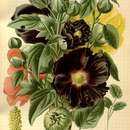Associations
provided by BioImages, the virtual fieldguide, UK
Foodplant / gall
Agrobacterium tumefaciens causes gall of stem (esp. base) of Alcea rosea
Foodplant / internal feeder
larva of Apion radiolus feeds within stem of Alcea rosea
Foodplant / sap sucker
nymph of Campylomma verbasci sucks sap of Alcea rosea
In Great Britain and/or Ireland:
Foodplant / parasite
Golovinomyces orontii parasitises live Alcea rosea
Foodplant / parasite
Leveillula taurica parasitises Alcea rosea
Foodplant / sap sucker
Macrosiphum euphorbiae sucks sap of live shoot (young) of Alcea rosea
Foodplant / saprobe
immersed, gregarious, often in lines pycnidium of Phoma coelomycetous anamorph of Phoma nebulosa is saprobic on dead stem of Alcea rosea
Foodplant / gall
pulvinate, hypophyllous telium of Puccinia malvacearum causes gall of live bract of Alcea rosea
Remarks: season: 4-11
Other: major host/prey
Comments
provided by eFloras
In Pakistan it is extensively cultivated throughout.
- license
- cc-by-nc-sa-3.0
- copyright
- Missouri Botanical Garden, 4344 Shaw Boulevard, St. Louis, MO, 63110 USA
Comments
provided by eFloras
Alcea rosea originated in the SW provinces of China and has been grown in Europe since at least the 15th century. It is cultivated as an
ornamental and is used medicinally. It is not known from any truly wild situations.
- license
- cc-by-nc-sa-3.0
- copyright
- Missouri Botanical Garden, 4344 Shaw Boulevard, St. Louis, MO, 63110 USA
Description
provided by eFloras
Erect annual herbs, 1-2.5 m tall. Stem rough stellate hairy, glabrescent. Leaves long petioled, large, round or ovate, at base cordate, at apex rounded, entire to 5-7 lobed, upper 3-lobed, crenate to dentate, scabrous and stellate pubescent on both sides. Flowers axillary, solitary or 2-3 in fascicles, spike like because of short pedicel in terminal branches, pedicel enlarged in fruit. Epicalyx segments 6-7, 1.5 cm long or more, fused below the middle, lanceolate to ovate. Calyx up to 1.5 times longer than epicalyx, both epicalyx and calyx stellate pubescent, scabrous. Corolla 5-7 cm across, of various colours; petals 4-7 cm long. Fruit depressed, globose; pubescent, enclosed by calyx, ± 2 cm across; mericarps 2C-40, channeled and winged dorsally, 5-7 mm across, back 1.5 mm broad.
- license
- cc-by-nc-sa-3.0
- copyright
- Missouri Botanical Garden, 4344 Shaw Boulevard, St. Louis, MO, 63110 USA
Description
provided by eFloras
Herbs biennial, erect, to 2(-3) m tall; stem densely hirsute. Stipules ovate, ca. 8 mm, apically 3-lobed; petiole 5-15 cm, stellate hirsute; leaf blade nearly orbicular, palmately 5-7-lobed or crenate-angled, 6-16 cm in diam., papery, abaxially long stellate hirsute or stellate tomentose, adaxially sparsely stellate pilose, lobes triangular or rounded, central lobe ca. 3 × 4-6 cm. Flowers solitary or fascicled, aggregated into a terminal, spikelike inflorescence. Bracts foliaceous. Pedicel ca. 5 mm, 8-10 mm in fruit, stellate hirsute. Epicalyx cup-shaped, usually 6- or 7-lobed, 8-10 mm, densely stellate hirsute, lobes ovate-lanceolate. Calyx campanulate, 2-3 cm in diam., lobes ovate-triangular, 1.2-1.5 cm, densely stellate hirsute. Corolla red, purple, white, pink, yellow, or black-purple, 6-10 cm in diam., sometimes double; petals obovate-triangular, ca. 4 cm, base attenuate, claw tipped with long thin hairs, apex emarginate. Staminal column glabrous, ca. 2 cm; filaments ca. 2 mm. Style branches many, puberulent. Schizocarp disk-shaped, ca. 2 cm in diam., puberulent; mericarps many, nearly orbicular, longitudinally grooved. Fl. Feb-Aug.
- license
- cc-by-nc-sa-3.0
- copyright
- Missouri Botanical Garden, 4344 Shaw Boulevard, St. Louis, MO, 63110 USA
Distribution
provided by eFloras
Of uncertain origin. Extensively cultivated.
- license
- cc-by-nc-sa-3.0
- copyright
- Missouri Botanical Garden, 4344 Shaw Boulevard, St. Louis, MO, 63110 USA
Distribution
provided by eFloras
Distribution: According to Zohary (l.c.) “wild Alcea rosea L. seems to be indigenous almost exclusively on the Aegean islands and the adjacent Balkan Peninsula. The areas of its origin are no doubt the north-eastern Mediterranean countries, but not China which is beyond the natural range of the genus”. Elsewhere cultivated.
- license
- cc-by-nc-sa-3.0
- copyright
- Missouri Botanical Garden, 4344 Shaw Boulevard, St. Louis, MO, 63110 USA
Habitat & Distribution
provided by eFloras
● Cultivated. Throughout China [widely introduced throughout temperate regions].
- license
- cc-by-nc-sa-3.0
- copyright
- Missouri Botanical Garden, 4344 Shaw Boulevard, St. Louis, MO, 63110 USA
Synonym
provided by eFloras
Althaea rosea (Linnaeus) Cavanilles; A. rosea var. sinensis (Cavanilles) S. Y. Hu; A. sinensis Cavanilles.
- license
- cc-by-nc-sa-3.0
- copyright
- Missouri Botanical Garden, 4344 Shaw Boulevard, St. Louis, MO, 63110 USA
Alcea rosea: Brief Summary
provided by wikipedia EN
Alcea rosea, the common hollyhock, is an ornamental dicot flowering plant in the family Malvaceae. It was imported into Europe from southwestern China during, or possibly before, the 15th century. William Turner, a herbalist of the time, gave it the name "holyoke" from which the English name derives.
- license
- cc-by-sa-3.0
- copyright
- Wikipedia authors and editors

